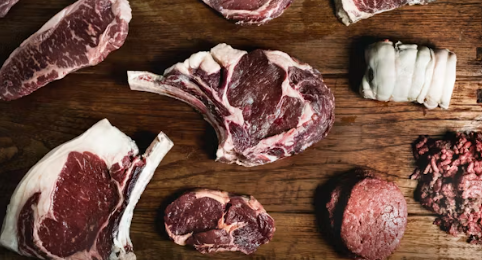Record beef prices are here—here’s why your next steak will cost a lot more
- Replies 1
If you’ve found yourself wincing at the checkout line while picking up a pack of steaks or ground beef, you’re not alone.
Across the country, Americans are feeling the pinch as beef prices hit historic highs, making that backyard burger or Sunday roast a pricier affair than ever before.
But what’s really behind this surge, and is there any relief in sight?
Let’s start with the numbers. According to the latest Consumer Price Index, beef and veal prices jumped 2.5% in July alone—outpacing the broader food category, which rose just 0.2%.
Over the past year, beef prices have soared by a whopping 11.3%. Ground beef? Up 11.5%. Uncooked steaks? A jaw-dropping 12.4% increase, both now at record levels.
To put it in dollars and cents:
So, what’s cooking up these high prices? It’s a classic case of supply and demand, with a few extra ingredients thrown in for good measure.
The consensus among agricultural economists and food policy experts? Don’t expect a quick fix.
Rebuilding cattle herds takes years, not months. Ranchers need stable feed prices and favorable weather before they’ll consider expanding.
Even then, it takes time for those new calves to grow into market-ready cattle.
Sylvain Charlebois, a food policy professor, sums it up,“ Short term, there’s no quick fix. It takes years to rebuild herds, and ranchers won’t start expanding until they’re confident feed prices and weather patterns stabilize.”
And while a dip in consumer demand could ease prices, that’s not exactly a solution anyone’s rooting for.
Read also: Costco shoppers are stocking up on these 11 bargains
If you’re thinking about swapping steak for chicken or pork, you’re not alone. Here’s how other meats have fared over the past year:
Read also: Walmart responds to new tariffs: which prices go up and which stay locked in
Some experts predict a modest dip in prices as we move past the summer grilling season, but don’t expect a return to the “good old days” anytime soon.
The USDA forecasts that the total US beef supply will drop to 31.1 billion pounds by August 2026—the lowest since 2019.
Unless we see a major shift in weather, feed costs, or trade policy, high prices could be with us for a while.
Read next: New trade tariffs could spike grocery prices—here’s how to stay ahead

We want to hear from you! Have you changed your shopping habits? Discovered a new favorite cut or recipe? Are you eating less beef, or finding creative ways to make it go further?
Across the country, Americans are feeling the pinch as beef prices hit historic highs, making that backyard burger or Sunday roast a pricier affair than ever before.
But what’s really behind this surge, and is there any relief in sight?
Let’s start with the numbers. According to the latest Consumer Price Index, beef and veal prices jumped 2.5% in July alone—outpacing the broader food category, which rose just 0.2%.
Over the past year, beef prices have soared by a whopping 11.3%. Ground beef? Up 11.5%. Uncooked steaks? A jaw-dropping 12.4% increase, both now at record levels.
To put it in dollars and cents:
- Ground beef: averaged $6.34 per pound in July, up from $5.62 just a year ago.
- Uncooked beef steaks: hit $11.88 per pound, compared to $10.86 last July.
So, what’s cooking up these high prices? It’s a classic case of supply and demand, with a few extra ingredients thrown in for good measure.
1. Shrinking Cattle Herds
The US cattle population has been on a slow decline. As of July, there were 94.2 million head of cattle and calves, with just 28.7 million classified as beef cattle. That’s down from 94.4 million and 31.3 million, respectively, in 2020. Years of drought, rising feed costs, and inflation have made cattle farming more expensive and less profitable, prompting many ranchers to reduce their herds.2. Weather Woes
Droughts in key beef-producing states have dried up pastures and driven up the cost of feed, making it harder for ranchers to maintain or grow their herds. When Mother Nature doesn’t cooperate, the ripple effects are felt all the way to your dinner plate.3. Rising Production Costs
Inflation isn’t just hitting consumers—it’s squeezing producers, too. Higher grain prices, increased interest rates, and labor shortages all add to the cost of raising cattle.4. Import Complications
To help fill the gap, the US has leaned more heavily on imported beef, especially for ground beef. Top sources include Australia, Canada, Mexico, New Zealand, and Brazil. But recent tariffs—like a hefty 50% tax on Brazilian beef—are making imports pricier and less plentiful. The USDA expects beef imports to drop by 6.1% next year, further tightening supply.5. Unyielding Demand
Americans love their beef. Despite rising prices, demand remains strong. As agricultural economist David P. Anderson puts it, “Everybody likes a good hamburger and steak.” When demand stays high and supply shrinks, prices inevitably climb.The consensus among agricultural economists and food policy experts? Don’t expect a quick fix.
Rebuilding cattle herds takes years, not months. Ranchers need stable feed prices and favorable weather before they’ll consider expanding.
Even then, it takes time for those new calves to grow into market-ready cattle.
Sylvain Charlebois, a food policy professor, sums it up,“ Short term, there’s no quick fix. It takes years to rebuild herds, and ranchers won’t start expanding until they’re confident feed prices and weather patterns stabilize.”
And while a dip in consumer demand could ease prices, that’s not exactly a solution anyone’s rooting for.
Read also: Costco shoppers are stocking up on these 11 bargains
If you’re thinking about swapping steak for chicken or pork, you’re not alone. Here’s how other meats have fared over the past year:
- General meats: Up 5.8%
- Chicken: Up 3.3%
- Pork: Up 1.1%
Read also: Walmart responds to new tariffs: which prices go up and which stay locked in
Some experts predict a modest dip in prices as we move past the summer grilling season, but don’t expect a return to the “good old days” anytime soon.
The USDA forecasts that the total US beef supply will drop to 31.1 billion pounds by August 2026—the lowest since 2019.
Unless we see a major shift in weather, feed costs, or trade policy, high prices could be with us for a while.
Read next: New trade tariffs could spike grocery prices—here’s how to stay ahead
Key Takeaways
- Beef prices in the United States have hit record highs, with average ground beef and steak prices rising more than 11 percent over the past year due to shrinking cattle herds and strong consumer demand.
- Long-term issues such as drought, high grain prices, rising interest rates, and increased production costs have led many farmers to reduce their herds, making supply shortages worse.
- Rising import tariffs, especially on Brazilian beef, and a decline in overall beef imports are expected to further strain supply and keep prices elevated for the foreseeable future.
- Experts predict that relief from high beef prices is unlikely for at least several years, as rebuilding cattle herds takes time and is dependent on more favorable weather and feed costs stabilizing.







